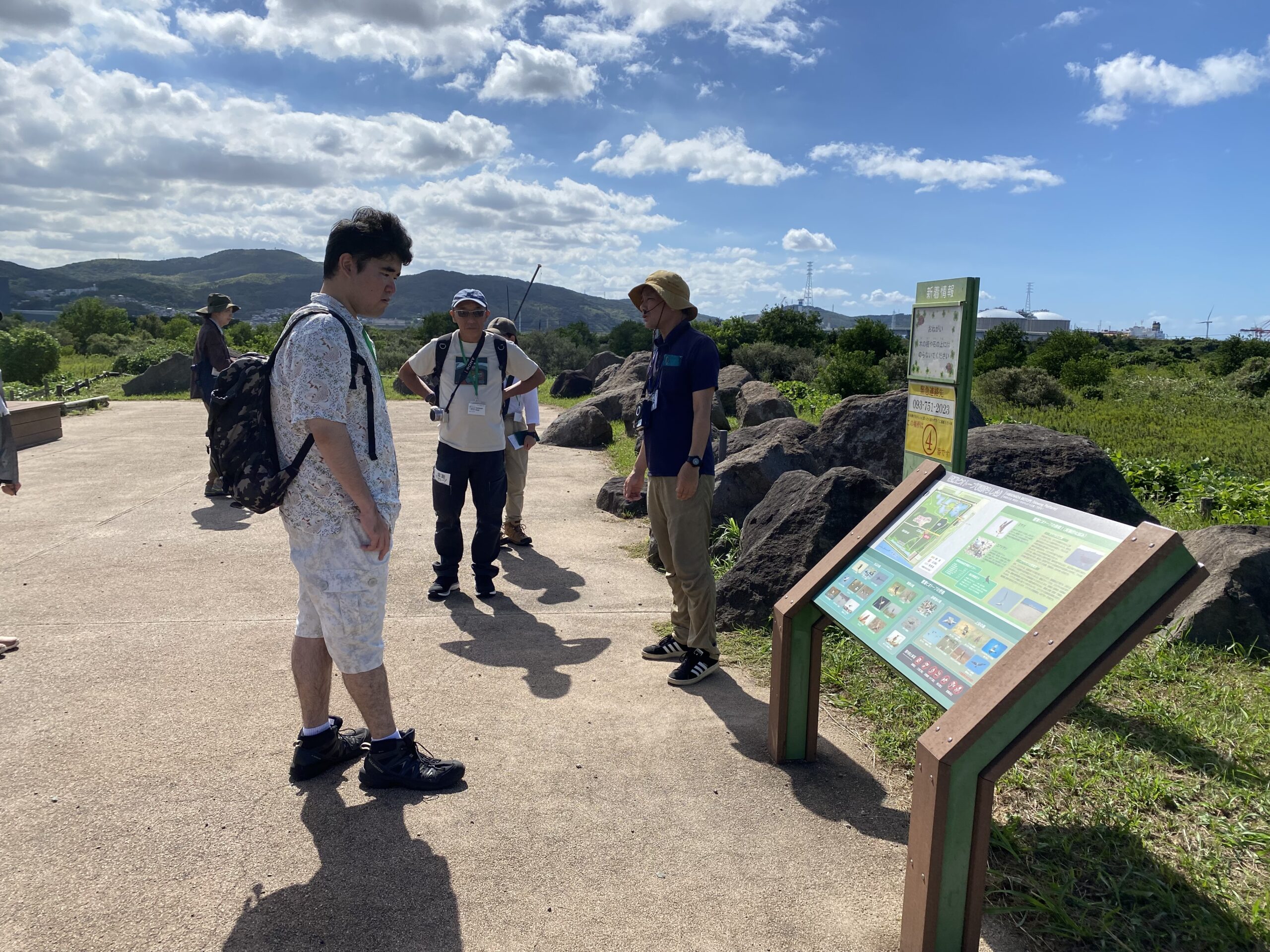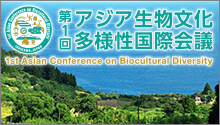2024/10/28
The International Consortium of Landscape and Ecological Engineering (ICLEE) celebrated its 20th anniversary with a conference, ICLEE2024, held from October 4 to 6, 2024, at the Kyushu Institute of Technology in Kitakyushu, Fukuoka Prefecture. This consortium includes six academic societies from Japan, Korea, and Taiwan that focus on the conservation, management, and restoration of the natural environment. Ms. Koyama (Researcher, UNU-IAS OUIK) participated in the event with the aim of learning from case studies in other regions and sharing research conducted after the Noto Peninsula earthquake.
The first day featured excursions to visit areas involved in waterfront restoration.
Our first stop was the Hibikinada Biotope, created on what was once a waste disposal site. This biotope, which includes wetlands and grasslands, was developed on land originally intended for industrial purposes. A protective water shield was installed to keep seawater, heavy metals, and toxins out, with the area being nourished solely by natural rainfall. Remarkably, no species were manually introduced here; instead, allowing nature to flourish has led to the discovery of over 800 species over the past three decades.
A variety of rare plants and animals inhabit this area. The presence of the bekko tonbo dragonfly (Libellula Angelina), which was first observed here in 1998 and is found in only five prefectures throughout Japan, prompted efforts to develop this site as a biotope. Additionally, several pairs of the eastern marsh harrier (Circus Spilonotus), of which only around 300 individuals exist nationwide, have settled in this biotope and are even breeding here. Furthermore, the area is home to little terns (Sterna albifrons) and harvest mouse (Micromys minutus). Along the fence surrounding the reclaimed land, plants that bear fruit favored by birds began to sprout from droppings deposited by birds 30 years ago, giving rise to a forest. Efforts have also been made in managing the wetland and constructing ponds to minimize the impact on the ecosystem.
Due to the ongoing construction of offshore wind farms and the reduction of grasslands in the surrounding area, it is expected that the landscape and ecosystem will change in the future. However, this location is likely to remain an important habitat for many living creatures.
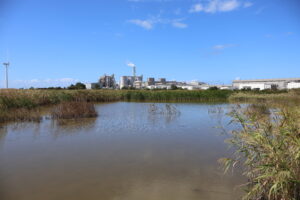 A spacious biotope established on reclaimed land |
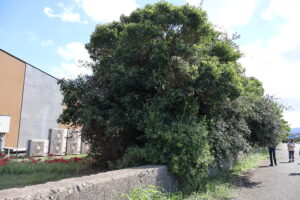 A forest flourishing along the fence of the reclaimed area |
Next, we visited the Onga River Fishway Park. The Onga River is a class A river that flows through northern Fukuoka Prefecture. In 1980, a weir (a structure that holds back river water) was constructed near the river mouth to supply water to the city of Kitakyushu. While a fishway was installed to allow fish to migrate, its design was such that fish with weaker swimming abilities were unable to ascend, and the riverbanks were covered with concrete. Therefore, around 15 years ago, a river environment improvement project was initiated. This project involved collaboration between Kyushu Institute of Technology and local residents, who worked together to develop the fishway park through workshops and other activities.
The newly designed fishway features a gentle slope that connects freshwater and seawater, allowing organisms to move freely. Stone seawalls have also been incorporated to provide passageways for wildlife, while trees like sandalwood and willow have sprouted from seeds carried by birds and wind. Artificial mudflats have been created to support crabs and shellfish. The park has been revitalized with lush greenery, including bike paths, and serves as an educational space for local children to learn about environmental stewardship.
During our visit, we witnessed a large school of mullet swimming upstream through the enhanced fishway, a testament to the ecosystem’s recovery. The Onga River Fishway Park has successfully created a rich waterside environment that draws both wildlife and visitors.
 Fishway Park, a gentle bridge between people and nature |
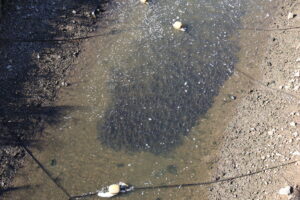 A large school of mullet making their way up the fishway from the estuary |
Finally, we visited Onga River Nakajima. This area, which was once land during the Kofun period, is home to several ancient burial mounds. It became a sandbar of approximately 28 hectares due to a river excavation project around the year 1700. For a long time, it was used for agriculture, but cultivation was abandoned in 1990. In 2008, a natural restoration project began, which involved excavating the land and restoring an 8-hectare wetland environment. Thanks to this initiative, the former floodplain has been revived, and fish species that inhabit wetlands, such as the stone moroko (Pseudorasbora parva) and the silver crucian carp (Carassius langsdorfii), can now be seen again. Currently, over 1,000 species of living organisms are thriving, restoring the richness of nature. However, if left unmanaged, the area tends to become overgrown with trees, so since five years ago, efforts have been made to maintain the wetland environment, including conducting controlled burns in early spring in certain areas.
This historic sandbar area now features a cycling path that is being utilized by local residents. While there are challenges to address, such as how to continue managing invasive species and other conservation efforts, the wetlands in the Onga River basin have lost about 90% of their original area, making them a rare and valuable habitat for the creatures that inhabit these wetlands.
 Bridge to the sandbar |
 Pond created on a sandbar |
On the morning of the second day, a symposium was convened to celebrate the 20th anniversary of the organization. Representatives from various member organizations and former ICLEE leaders shared their insights on the organization’s journey thus far and discussed initiatives for the future. The importance of collaborative efforts in tackling cross-border issues was highlighted, including challenges like yellow dust, the need for integrating biodiversity conservation strategies with climate change measures, the effectiveness of implementing numerous small-scale projects rather than just a few large-scale natural restoration efforts, and the significance of ecosystem recovery in rural areas alongside urban greening that respects ecological systems.
It was also emphasized that implementing green infrastructure with a focus on disaster prevention and environmental mitigation, along with efforts that acknowledge ecosystem continuity, plays a vital role in ensuring the health of future generations and the well-being of our planet. These are critical points that should be recognized across borders with a long-term view.

The Symposium
From the afternoon of the second day into the beginning of the third day, poster and oral presentations were held. Researcher Koyama presented a poster on a survey that examined the utilization of well water during a water supply disruption in Notojima, Nanao City. This survey was conducted in collaboration with Professor Seiji Yanai from Ishikawa Prefectural University following the Noto Peninsula earthquake. Questionnaires were distributed to all households, allowing the team to investigate and summarize the extent to which well water was utilized on the island and its significance during that time.
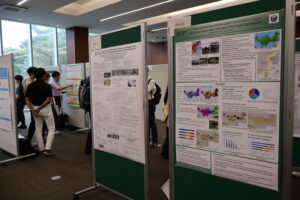
Poster Session
As we face a rise in disasters like heavy rainfall due to climate change, it has become clear that a collaborative approach is increasingly essential. Instead of tackling issues like climate change mitigation, biodiversity conservation, infrastructure development, and community and health initiatives separately, we need to foster cooperation among these areas so they can mutually enhance one another. OUIK intends to incorporate this insights into our future efforts.


